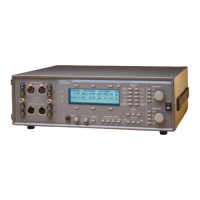The lower right soft key controls the reference for the delay
measurement. There are four options:
.
REF FRAME – Delay is measured from the start of a frame on
the reference input to the start of a frame on the input
.
OUT FRAME – Delay is measured from the start of a frame on
the digital output to the start of a frame on the input
.
REF BLOCK – Delay is measured from the start of a channel
status block on the reference input to the start of a block on the
input
.
OUT BLOCK – Delay is measured from the start of a channel
status block on the digital output to the start of a block on the
input
The lower center soft key controls the number of bits of data (or word
length) expected on the digital interface. The options are AUTO, 24,
22, 20, 18, or 16 bits. It should be set to match the number of bits of
resolution supported by the device-under-test. This setting affects
measurements (particularly THD and noise) in all the digital
measurement functions.
In AUTO mode, the resolution is determined by the incoming status
bits. The word width status bits are only defined for Professional
mode. If your device-under-test uses Professional mode, this is
usually the best choice. If your device-under-test uses Consumer
mode, the word width will default to 24 bits, which may be erroneous.
It is not recommended that you use AUTO in Consumer mode.
When AUTO mode is used, the word length will default to 24 bits if no
signal is applied.
The sweep mode is not available in Digital I/O measurement function.
& For more
information on the
Status Bits and
Consumer vs
Professional mode,
see pages 3-20 and
4-48.
4 Functions
Digital I/O Function Descriptions
4-44 ATS-1 Dual Domain User's Manual

